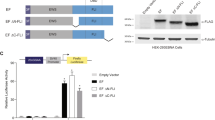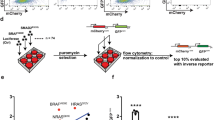Abstract
Two human hSos1 isoforms (Isf I and Isf II; Rojas et al., Oncogene 12, 2291 – 2300, 1996) defined by the presence of a distinct 15 amino acid stretch in one of them, were compared biologically and biochemically using representative NIH3T3 transfectants overexpressing either one. We showed that hSos1-Isf II is significantly more effective than hSos1-Isf I to induce proliferation or malignant transformation of rodent fibroblasts when transfected alone or in conjunction with normal H-Ras (Gly12). The hSos1-Isf II-Ras cotransfectants consistently exhibited higher saturation density, lower cell-doubling times, increased focus-forming activity and higher ability to grow on semisolid medium and at low serum concentration than their hSos1-Isf I-Ras counterparts. Furthermore, the ratio of GTP/GDP bound to cellular p21ras was consistently higher in the hSos1-Isf II-transfected clones, both under basal and stimulated conditions. However, no significant differences were detected in vivo between Isf I- and Isf II-transfected clones regarding the amount, stability and subcellular localization of Sos1-Grb2 complex, or the level of hSos1 phosphorylation upon cellular stimulation. Interestingly, direct Ras guanine nucleotide exchange activity assays in cellular lysates showed that Isf II transfectants consistently exhibited about threefold higher activity than Isf I transfectants under basal, unstimulated conditions. Microinjection into Xenopus oocytes of purified peptides corresponding to the C-terminal region of both isoforms (encompassing the 15 amino acid insertion area and the first Grb2-binding motif) showed that only the Isf II peptide, but not its corresponding Isf I peptide, was able to induce measurable rates of meiotic maturation, and synergyzed with insulin, but not progesterone, in induction of GVBD. Our results suggest that the increased biological potency displayed by hSos1-Isf II is due to higher intrinsic guanine nucleotide exchange activity conferred upon this isoform by the 15 a.a. insertion located in proximity to its Grb2 binding region.
This is a preview of subscription content, access via your institution
Access options
Subscribe to this journal
Receive 50 print issues and online access
$259.00 per year
only $5.18 per issue
Buy this article
- Purchase on Springer Link
- Instant access to full article PDF
Prices may be subject to local taxes which are calculated during checkout








Similar content being viewed by others
References
Aronheim A, Engelberg LN, Al-Alawi N, Schlessinger J and Karin M. . 1994 Cell 78: 949–961.
Aroca P, Mahadevan D and Santos E. . 1996 Oncogene 13: 1839–1846.
Baltensperger K, Kozma LM, Cherniack AD, Klarlund JK, Chawla A, Banerjee U and Czech MP. . 1993 Science 260: 1950–1952.
Benito M, Porras A, Nebreda AR and Santos E. . 1991 Science 253: 565–568.
Boguski MS and McCormick F. . 1993 Nature 366: 643–654.
Buday L and Downward J. . 1993 Cell 73: 611–620.
Byrne JL, Paterson HF and Marshall CJ. . 1996 Oncogene 13: 2055–2065.
Chan AML, Fleming TP, McGovern ES, Chedid M, Miki T and Aaronson SA. . 1993 Mol. Cell. Biol. 13: 762–768.
Chardin P, Camonis JH, Gale NW, Van Aelst L, Schlessinger J, Wigler MH and Bar-Sagi D. . 1993 Science 260: 1338–1343.
Cherniack AD, Klarlund JK and Czech MP. . 1994 J. Biol. Chem. 269: 4717–4720.
Chuang LM, Myers MG, Backer JM, Shoelson SE, White M, Birnbaum MJ and Khan R. . 1993 Mol. Cell. Biol. 13: 6653–6660.
Corbalan-Garcia S, Yang SS, Degenhardt KR and Bar-Sagi D. . 1996 Mol. Cell. Biol. 16: 5674–5682.
Corbalan-Garcia S, Margarit SM, Galron D, Yang S and Bar Sagi D. . 1998 Mol. Cell. Biol. 18: 880–886.
Deshpande AK and Kung HF. . 1987 Mol. Cell. Biol. 7: 1285–1288.
Di Fiore PP, Pierce JH, Fleming TP, Hazan R, Ullrich A, King CR, Schlessinger J and Aaronson SA. . 1987a Cell 51: 1063–1070.
Di Fiore PP, Pierce JH, Kraus MH, Segatto O, King CR and Aaronson SA. . 1987b Science 237: 178–182.
Douville E and Downward J. . 1997 Oncogene 15: 373–383.
Downward J. . 1994 FEBS Lett. 338: 113–117.
Egan SE and Weinberg RA. . 1993 Nature 365: 781–783.
Egan SE, Giddings BW, Brooks MW, Buday L, Sizeland AM and Weinberg RA. . 1993 Nature 363: 45–51.
Feig LA. . 1994 Curr. Op. Cell Biol. 6: 204–211.
Font de Mora J, Guerrero C, Mahadevan D, Coque JJR, Rojas JM, Esteban LM, Rebecchi M and Santos E. . 1996 J. Biol. Chem. 271: 18272–18276.
Gibbs JB, Schaber MD, Marshal MS, Scolnick EM and Sigal IS. . 1987 J. Biol. Chem. 262: 10426–10429.
Gibbs JB, Schaber MD, Schofield TL and Scolnick EM. . 1989 Proc. Natl. Acad. Sci. USA 86: 6630–6634.
Heidaran MA, Fleming TP, Bottaro DP, Bell GI, Di Fiore PP and Aaronson SA. . 1990 Oncogene 5: 1265–1270.
Heidaran MA, Molloy CJ, Panqelinan M, Choudhury GG, Wang LM, Fleming TP, Sagakuchi AY and Pierce JH. . 1992 Oncogene 7: 147–152.
Holsinger LJ, Spencer DM, Austin DJ, Schreiber SL and Crabtree GR. . 1995 Proc. Natl Acad. Sci. USA 92: 9810–9814.
Karlovich CA, Bonfini L, McCollam L, Rogge RD, Daga A, Czech MP and Banerjee U. . 1995 Science 268: 576–579.
Katzav S, Packham G, Sutherland M, Aroca P, Santos E and Cleveland JL. . 1995 Oncogene 11: 1079–1088.
Korn LJ, Siebel CW, McCormick F and Roth RA. . 1987 Science 236: 840–843.
Lacal JC and Aaronson SA. . 1986 Proc. Natl. Acad. Sci. USA 83: 5400–5404.
Li BQ, Kaplan D, Kung HF and Kamata T. . 1992 Science 256: 1456–1459.
Li BQ, Subleski M, Shalloway D, Kung HF and Kamata T. . 1993a Proc. Natl. Acad. Sci. USA 90: 8504–8508.
Li BQ, Wang KH, Kung HF, Ronsin C, Breathnach R, Leonard EJ and Kamata T. . 1995 Biochem. Biophys. Res. Commun. 216: 110–118.
Li BQ, Subleski M, Fusaki N, Yamamoto T, Copeland T, Princler G, Kung HF and Kamata T. . 1996 Proc. Natl. Acad. Sci. USA 93: 1001–1005.
Li N, Batzer A, Daly R, Yajnik V, Skolnik E, Chardin P, Bar-Sagi D, Margolis B and Schlessinger J. . 1993b Nature 363: 85–88.
Lowenstein EJ, Daly RJ, Batzer AG, Li W, Margolis B, Lammers R, Ullrich A, Skolnik EY, Bar Sagi D and Schlessinger J. . 1992 Cell 70: 431–442.
McCollam L, Bonfini L, Karlovich CA, Conway BR, Kozma LM, Banerjee U and Czech MP. . 1995 J. Biol. Chem. 270: 15954–15957.
McCormick F. . 1993 Nature 363: 15–16.
Mendelson AR and Brent R. . 1994 Curr. Op. in Biotechnology 5: 482–486.
Muslin A, Klippel A and Williams LT. . 1993 Mol. Cell. Biol. 13: 6661–6666.
Pawson T and Schlessinger J. . 1993 Curr. Biol. 3: 4345–4442.
Porfiri E and McCormick F. . 1996 J. Biol. Chem. 271: 5871–5877.
Quilliam LA, Huff SY, Rabun KM, Wei W, Park W, Broek D and Der CJ. . 1994 Proc. Natl. Acad. Sci. USA 91: 8512–8516.
Quilliam LA, Khosravi-Far R, Huff SY and Der CJ. . 1995 Bioessays 17: 395–404.
Rojas JM, Coque JJR, Guerrero C, Aroca P, Font de Mora J, de la Cruz X, Lorenzi MV, Esteban LM and Santos E. . 1996 Oncogene 12: 2291–2300.
Rozakis-Adcock M, Fernely R, Wade J, Pawson T and Bowtell D. . 1993 Nature 363: 83–85.
Rozakis-Adcock M, van der Geer P, Mbamalu G and Pawson T. . 1995 Oncogene 11: 1417–1426.
Sasaoka T, Draznin B, Leitner JW, Langlois WJ and Olefsky JM. . 1994 J. Biol. Chem. 269: 10734–10738.
Satoh T, Endo M, Nakafuku M, Akiyama T, Yamamoto T and Kaziro Y. . 1990 Proc. Natl. Acad. Sci. USA 87: 7926–7929.
Schlessinger J. . 1993 Trends Biochem. Sci. 18: 273–276.
Sorrentino V, Nebreda AR, Alonso T and Santos E. . 1989 Oncogene 4: 215–221.
Skolnik EY, Lee CH, Batzer A, Vicentini LM, Zhou M, Daly R, Myers MJ, Backer JM, Ullrich A, White MF and Schlessinger J. . 1993 EMBO J. 12: 1929–1936.
Tauchi T, Feng GS, Marshall MS, Shen R, Mantel C, Pawson T and Broxmeyer HE. . 1994 J. Biol. Chem. 269: 25206–25211.
Wang W, Fisher EMC, Jia Q, Dunn JM, Porfiri E, Downward J and Egan SE. . 1995 Nature Gen. 10: 294–300.
Wigler M, Silverstein S, Lee LS, Pellicer A, Cheng Y and Axel R. . 1977 Cell 11: 223–232.
Acknowledgements
Helpful suggestions and support from Drs M Alimandi, J Rubin and W Taylor are gratefully acknowledged. JJRC was a postdoctoral fellow from Fundacion Ramon Areces, Spain and NZ was a predoctoral fellow from Instituto de Salud Carlos III (Spain). JMR was supported in part by grant DGICYT (PM95-0053).
Author information
Authors and Affiliations
Rights and permissions
About this article
Cite this article
Rojas, J., Subleski, M., Coque, J. et al. Isoform-specific insertion near the Grb2-binding domain modulates the intrinsic guanine nucleotide exchange activity of hSos1. Oncogene 18, 1651–1661 (1999). https://doi.org/10.1038/sj.onc.1202483
Received:
Revised:
Accepted:
Published:
Issue Date:
DOI: https://doi.org/10.1038/sj.onc.1202483
Keywords
This article is cited by
-
A review of the biological and clinical implications of RAS-MAPK pathway alterations in neuroblastoma
Journal of Experimental & Clinical Cancer Research (2021)
-
The CSN3 subunit of the COP9 signalosome interacts with the HD region of Sos1 regulating stability of this GEF protein
Oncogenesis (2019)
-
The isoform-specific stretch of hSos1 defines a new Grb2-binding domain
Oncogene (2000)



